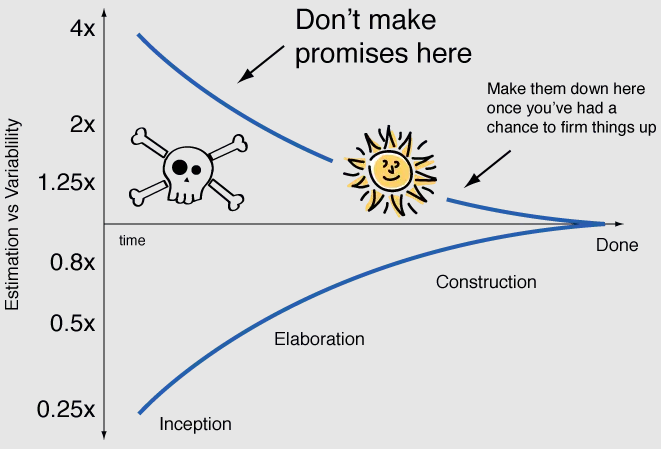Time and money
I'll start with the main thing: no one knows how much it really costs to create your application/website
Coming to the studio, customers find themselves in the wild west of estimation: estimates are given without analytics, without understanding the product and based on internal feelings.
Studios shoot into the air, hoping to meet the expectations of the client.
Studios shoot into the air, hoping to meet the expectations of the client.
Cone of uncertainty
In Agile, there is such a thing as a cone of uncertainty. If you received an assessment at the stage of the first immersion in the product, then be prepared for a 4-fold increase.
The estimate of your project in IT is a living organism. It should and will change over time. You need to accept this and be able to work with it. To do this, you need to constantly communicate with the team and ask them to update forecasts.
In Agile, there is such a thing as a cone of uncertainty. If you received an assessment at the stage of the first immersion in the product, then be prepared for a 4-fold increase.
The estimate of your project in IT is a living organism. It should and will change over time. You need to accept this and be able to work with it. To do this, you need to constantly communicate with the team and ask them to update forecasts.

Working conditions
Many studios will offer you a standard scheme:
write a technical specification (TOR)
, make an assessment on the TOR
, sign a contract with a fixed amount of payment
All according to the classics — 50% advance, N months of work, I accept work according to the TOR, the remaining 50% at the end.
It seems that everything is very simple. A 20-minute adventure. Unfortunately, this format is not suitable for creating something more complicated than landing on a tilde. The problems start with the terms of reference.
Many studios will offer you a standard scheme:
write a technical specification (TOR)
, make an assessment on the TOR
, sign a contract with a fixed amount of payment
All according to the classics — 50% advance, N months of work, I accept work according to the TOR, the remaining 50% at the end.
It seems that everything is very simple. A 20-minute adventure. Unfortunately, this format is not suitable for creating something more complicated than landing on a tilde. The problems start with the terms of reference.

Technical specification
The terms of reference are important. Without it, you will not be able to translate your business requirements into the development language. The main mistake is to sign the TK at the very start of the work, thinking that the TK is a plan.
IT products are not created according to plan — there is too much uncertainty in the development. Therefore, the TK should and will change, it's not scary. It's scary to agree on new terms and price every time the product changes.
Why do many studios still offer the customer to sign the TOR and work strictly according to it? I believe that this is due to the unwillingness of both sides to build trusting relationships. If you do not have a trusting relationship, then you will spend more time on negotiations and reassessments than on the product itself.
The terms of reference are important. Without it, you will not be able to translate your business requirements into the development language. The main mistake is to sign the TK at the very start of the work, thinking that the TK is a plan.
IT products are not created according to plan — there is too much uncertainty in the development. Therefore, the TK should and will change, it's not scary. It's scary to agree on new terms and price every time the product changes.
Why do many studios still offer the customer to sign the TOR and work strictly according to it? I believe that this is due to the unwillingness of both sides to build trusting relationships. If you do not have a trusting relationship, then you will spend more time on negotiations and reassessments than on the product itself.
About fixed payment
The price of developing your project will vary. Developers will find out the real price only during the development process. But the fixed amount in the contract will not change. Therefore, the developers will either charge you an extra 50% for the risks, or they will sell you improvements at a triple price in order to recapture losses from an incorrect assessment at the beginning.
The main problem is that you don't control how much time developers spend on tasks and can't make the right decisions. Sometimes it's better to remove a complex feature than to spend all the money on it and not get the product.
The fixed payment format does not require the customer to constantly interact with the performers, which has a bad effect on the product. You will most likely spend more money than in other work formats.
The price of developing your project will vary. Developers will find out the real price only during the development process. But the fixed amount in the contract will not change. Therefore, the developers will either charge you an extra 50% for the risks, or they will sell you improvements at a triple price in order to recapture losses from an incorrect assessment at the beginning.
The main problem is that you don't control how much time developers spend on tasks and can't make the right decisions. Sometimes it's better to remove a complex feature than to spend all the money on it and not get the product.
The fixed payment format does not require the customer to constantly interact with the performers, which has a bad effect on the product. You will most likely spend more money than in other work formats.
About TM
Time&Material (TM) is a format of work in which you pay only for the hours actually spent by developers. You just tell the performers what to do.
This is usually a memo, a chat message, or the same tech. task. Developers perform tasks, record hours spent, PM gives reports every week, pay for hours at the end of the month.
With this model of work, you:
Get control over the spending of your project budget (rather than putting the entire budget under the control of the contractor)
You get transparent analytics on labor costs and can make product decisions
You can quickly change the requirements — there is no need to re-evaluate the signed TK
You control the deadlines, as you see the speed of the team in dynamics
Time&Material (TM) is a format of work in which you pay only for the hours actually spent by developers. You just tell the performers what to do.
This is usually a memo, a chat message, or the same tech. task. Developers perform tasks, record hours spent, PM gives reports every week, pay for hours at the end of the month.
With this model of work, you:
Get control over the spending of your project budget (rather than putting the entire budget under the control of the contractor)
You get transparent analytics on labor costs and can make product decisions
You can quickly change the requirements — there is no need to re-evaluate the signed TK
You control the deadlines, as you see the speed of the team in dynamics
What are the pitfalls?
TM-format implies active work on the part of both the contractor and the customer. You definitely need to:
Record the tasks that you assign to performers
Clearly and clearly explain the requirements and make sure that the contractor has understood them correctly
Require hourly reports and progress demonstrations every 1-2 weeks
And the main thing is to learn to trust the performer. In the end, you will never be able to prove that the developers spent exactly as many hours as they told you.
My studio develops and launches IT products for startups, so without flexibility we would not be able to do what we do.
TM-format implies active work on the part of both the contractor and the customer. You definitely need to:
Record the tasks that you assign to performers
Clearly and clearly explain the requirements and make sure that the contractor has understood them correctly
Require hourly reports and progress demonstrations every 1-2 weeks
And the main thing is to learn to trust the performer. In the end, you will never be able to prove that the developers spent exactly as many hours as they told you.
My studio develops and launches IT products for startups, so without flexibility we would not be able to do what we do.
6 tips for the customer
- Work by TM (or at least with payment for stages)
- Be constantly involved in the process
- Demand reports on labor costs
- Ask to update the score over time
- Be ready for changes and not tie everything to TK
- Don't work with a performer without trust
Thank you for reading to the end! I will be glad to talk to everyone and tell you more about the creation and launch of startups — I ask you to telegram: @dimtsaplia
